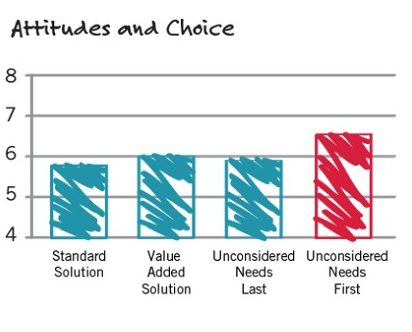Tap the Power of the Unexpected to Give Your Story "Tipping Point" Potential
The who, when, where and how surrounding a B2B sales opportunity is vital information to know. But it won’t close the deal. The real clincher lies in knowing what to say (crafted, of course, around why prospects should care). From a sales rep’s lips to a prospect’s ear: what is said bears a hefty onus – and a charismatic delivery alone won’t to carry it off. Bottom line: B2B sales messages must be powerful enough to break through a bubble of indifference…and compelling enough to change buyers’ minds.
Research suggests sales’ biggest competitor may not be a fellow vendor, but the “do-nothing” comfort zone of the status quo. In fact, about 60% of qualified leads fail to convert because the buyer fails to find value in purchasing something new.
How can marketers help persuade passive buyers to embrace a change? Unsettle their mindset with a different story, advises Corporate Visions, Inc., CSO and CMO Tim Riesterer. More specifically, hinge your story on the unexpected.
Pseudo Insights Won’t Save Sales
For the past seven years, Riesterer has steered the business strategy at Corporate Visions, a marketing and sales consulting firm that specializes in equipping B2B companies with skills, tools and stories for winning sales conversations.
“Some companies out there want us to prettify their PowerPoint presentations – and that’s not us,” says Riesterer, whose clientele includes many Fortune 500™ companies throughout 11 countries. “Our specialty is transforming sales conversations with a combination of the right story and the right skills.”
Corporate Visions’ wares are well-timed. Due to the growing popularity of B2B self-service, Forrester Research has predicted the demise of sales pros who don’t shift to a consultative selling approach. The analyst firm expects one million B2B sales jobs to be eliminated by 2020.
“Forrester’s prediction is an indictment for sales. Those who fall into order taker, explainer and navigator archetypes will eventually be replaced by algorithms,” Riesterer says. “To save the profession, sales must add value – now.”
When Riesterer talks about sales “adding value,” he’s referring to a shared responsibility with marketing. Sales pros can earn a gold star in skills training, but if they’re using an ineffective talk track or slides that are misaligned with solution selling, they are unlikely to close deals.
Imagine what this feels like from a prospect’s perspective. Let’s say you’ve been regularly reading a B2B brand’s thought leadership content for a couple months. You’ve subscribed to the company’s newsletter for marketing executives, downloaded a few whitepapers and attended a best practices webinar. You’re leisurely enjoying the brand’s insights. Then suddenly a salesperson calls, assaulting your ear with a product-pushing spiel.
“As a potential buyer, your head is at a thought leadership altitude, so when the salesperson starts rambling on about product features and benefits, you start to feel like a deep sea diver who’s descending too fast,” Riesterer says. “You may start to nod off."
Conversely, winning sales conversations deliver insights. Riesterer notes that businesses often mistake a seemingly compelling data point for “insight.” True insights are visionary, Riesterer explains; they’re forward-looking and they incite/trigger action. Ideally, these insights are gleaned from original, primary research conducted by the company that uses them. A statistic from a respected third party (such as an industry analyst) is little more than recycled data. It’s publicly available. Anyone – including your competitors – can use it (and probably are).
Riesterer’s rule of thumb for adding unique value to sales conversations is simple, but not easy to achieve. “Don’t just pass along numbers; tell a story,” he says.
Facts Tell, But Stories Sell*
When it comes to storytelling, Malcolm Gladwell is Riesterer’s “personal hero.”
“In The Tipping Point, Gladwell basically sells us a 40 year-old idea that originated with Morton Grodzins, a professor of political science at the University of Chicago,” he says. “While Grodzins’ idea faded into academic obscurity, Gladwell’s version moved people and became very popular – all because he told a better story.”
In Riesterer’s estimation, what makes Gladwell’s story “better” than that of Grodzins is its accessibility and applicability. In Gladwell’s book, the notion of “the tipping point” becomes something real, relevant and, of course, sticky. (Who doesn’t relate emotionally to “the magic moment when an ideal or social behavior crosses a threshold, tips and spreads like wildfire”?) Gladwell’s tipping point is something on which we can—and indeed, are compelled to – take action.
Sales and marketing would do well to take a page from Gladwell’s playbook. So what goes into telling a better story? According to Riesterer, the secret sauce to a winning sales pitch lies in perfecting the art of persuasion, which requires a solid understanding of decision-making psychology.
This is where B2B marketers and sales pros stumble. (After all, how often do you see B2B pitches opening with a statement or statistic that restates the buyer’s recognized “pain point”?) Persuading a prospect to move away from the status quo requires a very different approach, and it’s not about confirming the buyer’s current reality.
“People are open to persuasion only when there’s uncertainty. Don’t tell them what they already know. Set yourself apart by messaging to what they don’t know,” Riesterer says. “Talk about needs they’ve overlooked, underestimated or don’t know about.”
Riesterer calls the element of surprise in a successful sales pitch the “unconsidered need.” And building a story around the unconsidered need is nothing short of counterintuitive. Consider the following scenario that Riesterer uses at speaking engagements…
- A credit union performs a consumer behavior research.
- The research reveals that Millennials loathe debt.
- In fact, the study finds 64% of Millennials have zero debt.
If you were the credit union, how would you structure a home loan sales pitch to Millennials?
“You’d be surprised how often I get the Captain Obvious answer,” Riesterer says, sighing. “It never fails. Somebody always says it’s a good idea to lead with ‘36% of Millennials have debt’ and then go on to showcase their low interest rates.”
In contrast, the same sales pitch built around the unconsidered need would open with “64% of Millennials have zero debt. Of those, a high percentage (X%) won’t be granted a home loan.” Admittedly, this opener is more “negative” than many B2B marketers are comfortable with. (Their companions in sales may have similar feelings, as they’re not usually fans of introducing conflict or tension in a prospect interaction). Yet, it’s the unexpectedness of this statement that introduces uncertainty, dislodges business-as-usual bias and ultimately paves the way for do-nothing buyers to make a change – something that won’t happen by highlighting a pain of which buyers are all too cognizant.
“Customers are already aware of most of their business needs. If they haven’t filled them yet, it’s because they believe they have some control over them; they’ve used duct tape or something else to make the situation tolerable,” says Riesterer, whose third book, The Three Value Conversations, hit bookshelves in August.
“The needs they know about – but aren’t acting on – haven’t killed them yet…but the needs they don’t know about – well, they’re not sure what will happen if they don’t take action on those.”
Science Says “Yes” to the Unexpected
The unconsidered need is not just another newfangled buzzword or gut-fueled hypothesis. It’s a phenomenon in decision-making psychology—the effectiveness of which is backed by scientific research. Corporate Visions, in conjunction with Dr. Zakary Tormala, a professor at the Stanford Graduate School of Business, recently conducted a study to determine how (if at all) the unconsidered moved B2B buyers. The research revealed sales pitches built around the unconsidered need outperformed other pitches.

Attitudes and choice; scales ranged from 1 to 9 with higher ratings indicating more favorable attitudes and more likely to choose. Attitudes and choice likelihood ratings were more favorable in the unconsidered needs first condition (by nearly 10.3%) than in the other three, none of which differed from one another. Image credit: Corporate Visions, Inc. via CMO.com
To get prospects to break through their “do-nothing,” perceived “safe” stance, motivate them to challenge their assumptions about the market. Your success in this endeavor lies not just in the story itself, but also the order in which it’s told.
ADP: A Good “Tipper”
When asked who excels at persuasive storytelling, Riesterer cites employee payroll solutions provider ADP.
“ADP is able to look at topical issues and data points of the day – and frame counterintuitive, disruptive opinions. The insights they share are sellable and actionable,” he says. “By the end of a sales call, they’ve persuaded prospects to try on the provocative point of view and actually start to take ownership of it.”
At ADP, both the sales and marketing teams are forward-leaning; they’ve worked hard to close the conversion gap between misaligned content and consultative selling. Their content marketers know what sales pros are being trained to say and do, and sales knows how their pitches align with marketing’s thought leadership content. Neither team has resigned itself to the organizational inertia that often creeps between skills and story.
Ultimately, what gives a story “tipping point” power is its ability to move people to take action. In Gladwell’s words:
- In the end, Tipping Points are a reaffirmation of the potential for change and the power of intelligent action. Look at the world around you.
- It may seem like an immovable, implacable place. It is not. With the slightest push—in just the right place—it can be tipped.
So stop building cautious stories that reinforce the status quo. Instead, look to the future, differentiate your perspective and have the courage to start unsafe conversations.
Let the tipping begin.
Image credit: "Tipping Point - Brimham Rocks" by Harry (Howard) Potts, Flickr http://ow.ly/P2F2O

